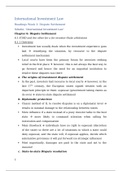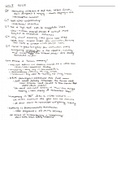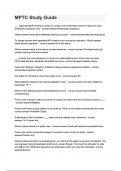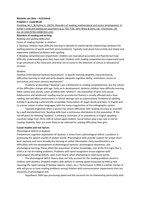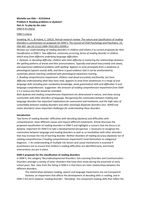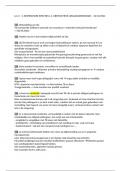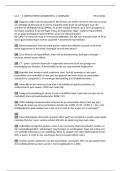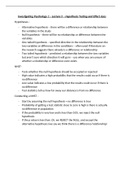International Investment Law
Readings Week 3: Dispute Settlement
Schefer, ‘International Investment Law’
Chapter 6: Dispute Settlement
6.1 ICSID and the other for a for investor-State arbitration
6.1.1 Overview
Investment law usually deals when the investment experience goes
bad remedying the situation, by recourse to the dispute
settlement mechanism
Local courts have been the primary forum for investors seeking
relief in the frst place however, this is not always the best way to
go forward and hence the need for an impartial institution to
resolve these disputes was there
a. The origins of investment dispute settlement
In the past, investors had recourse to local courts however, in the
late 17th century, the European states signed treaties with an
important principle in them: espousal (government taking claims as
its own) state-to-state dispute settlement
b. Diplomatic protection
Classic method of IL to resolve disputes is on a diplomatic level
results in minimal damage to the relationship between states
More infuence if a state instead of a puny investor talks to the host
state more likely to command attention when calling for
restoration and compensation
Main drawback individuals have no right to espousal (discretion
of the state) so there are a lot of situations in which a state could
deny espousal, and the state will, if espousal applies, decide which
substantive provisions it will put forward (so strategic infuence)
Most importantly, damages are paid to the state and not to the
investor!
c. State-to-state Dispute resolution
1
, If there is an investment treaty, the home state can also bring a
claim under that treaty (if so provided of course) ICJ will then
resolve the dispute (ELSI and Barcelona Light and Traction were
decided by the ICJ)
Also, a possibility that there is state-to-state arbitration instead of
ICJ proceedings BIT may so provide
d. Use of force
Precluded nowadays if there is no SC Resolution on the matter in
the old days, it was quite common for a state to use force to secure
its investments however, some investors did not want this kind of
infuence of the home state on their private contractual
relationships with local suppliers etc.
1907: Drago-Porter Convention made the use of force for recovery
of state debts illegal unless the host state refused to submit to
arbitration now replaced by UN Charter Article 2(4)
e. Arbitration between the investor and the host state
Why bring in a third party? move from state-to-state to investor-
state dispute settlement
Diplomatic protection still possible, as is state-to-state dispute
settlement
Why is it attractive? no espousal problems, own claims, full damage
collection if successful
Problem: the host, as it is reluctant to be sued by an individual in
front of an international dispute settlement body, state is immune
from legal actions
6.1.2 Dispute settlement between investors and their host states:
investor-State arbitration
In the early days ad hoc tribunals dealing with these claims, or
event-specifc tribunals (such as the Jay Treaty tribunals for
revolutionary war claims)
After WWII arbitration on the basis of investment contracts and
consent-to-arbitrate clauses contained therein
2
, In the 1950s more and more BITs, more and more BITs including
ISDS provisions, including a general consent-to-arbitrate provision
binding on the treaty parties moving away from the contract-
based consent, fundamentally changing the host’s liability
Consent in the treaty is open-ended (arbitration without privity),
investor can claim violations on all of the treaty provisions (except if
there was a limited consent from the parties to only arbitrate
certain types of claims, such as compensation for expropriation)
a. International Centre for Settlement of Investment Disputes
(ICSID)
a.i History and role of ICSID
Attempts for multilateral investment protection treaty within the
OECD failed
Broches idea to focus on procedure rather than on substance, so
idea for World Bank multilateral investment dispute settlement
body ICSID (established in 1966)
a.ii Structure of the ICSID as an organisation
Form and purpose
Part of the World Bank, located in Washington purpose is to
provide facilities for conciliation and arbitration of investment
disputes between contracting states and nationals of other
contracting states
Possesses legal personality, ICSID and staf enjoy immunities
relevant to their positions
Membership
Membership is open to World Bank members or parties to the ICJ
invited by 2/3rds of the other ICSID members to join (Article 67
ICSID Convention)
Signing + ratifying the ICSID Convention 30 days afterwards
begins the membership
2016: 153 Member states, all industrial countries included
Non-members: Brazil, India, Mexico, Poland, Russia open to
arbitration within the Additional Facility
3
, Infuence of ICSID arbitrations means that their doctrine will trickle
down into other arbitral tribunals
Organisational structure
Administrative Council
Composed of one representative of each ICSID member and the
president of the World Bank (non-voting chair), meets once a year,
egalitarian voting system, decides on administrative, budgetary,
procedural and substantive matters
Secretariat
Daily operational aspects, led by the Sec-Gen administration of
disputes, maintenance of the panel of arbitrators and conciliators
Panel of arbitrators and panel of conciliators
External individuals needed for settlement of disputes proposed
by the members, four per list
Article 14.1 ICSID Convention: ‘high moral character and
recognised competence in the felds of law, commerce, industry or
fnance, who may be relied upon to exercise independent judgment’
Remain on the list for four years, possibility of renewal by the
member appointment to a tribunal is far from assured, as
disputants may choose non-listed persons as tribunal members, only
if ICSID itself composes the tribunal the listed arbitrators can be
selected
Growth of the ICSID
Large burden on ICSID because the case load is becoming heavier
every year hence there are pressure on the ICSID to increase its
capacity
a.iii Dispute Settlement procedure
ICSID is open to everyone, having an Additional Facility for
investors from non-members or non-member states
Additional Facility to permit investors from or in non-ICSID states
to access the ICSID, to permit arbitrations on issues that do not
arise directly out of an investment, or to perform fact-fnding
procedural rules generally the same as the normal procedure
4
Readings Week 3: Dispute Settlement
Schefer, ‘International Investment Law’
Chapter 6: Dispute Settlement
6.1 ICSID and the other for a for investor-State arbitration
6.1.1 Overview
Investment law usually deals when the investment experience goes
bad remedying the situation, by recourse to the dispute
settlement mechanism
Local courts have been the primary forum for investors seeking
relief in the frst place however, this is not always the best way to
go forward and hence the need for an impartial institution to
resolve these disputes was there
a. The origins of investment dispute settlement
In the past, investors had recourse to local courts however, in the
late 17th century, the European states signed treaties with an
important principle in them: espousal (government taking claims as
its own) state-to-state dispute settlement
b. Diplomatic protection
Classic method of IL to resolve disputes is on a diplomatic level
results in minimal damage to the relationship between states
More infuence if a state instead of a puny investor talks to the host
state more likely to command attention when calling for
restoration and compensation
Main drawback individuals have no right to espousal (discretion
of the state) so there are a lot of situations in which a state could
deny espousal, and the state will, if espousal applies, decide which
substantive provisions it will put forward (so strategic infuence)
Most importantly, damages are paid to the state and not to the
investor!
c. State-to-state Dispute resolution
1
, If there is an investment treaty, the home state can also bring a
claim under that treaty (if so provided of course) ICJ will then
resolve the dispute (ELSI and Barcelona Light and Traction were
decided by the ICJ)
Also, a possibility that there is state-to-state arbitration instead of
ICJ proceedings BIT may so provide
d. Use of force
Precluded nowadays if there is no SC Resolution on the matter in
the old days, it was quite common for a state to use force to secure
its investments however, some investors did not want this kind of
infuence of the home state on their private contractual
relationships with local suppliers etc.
1907: Drago-Porter Convention made the use of force for recovery
of state debts illegal unless the host state refused to submit to
arbitration now replaced by UN Charter Article 2(4)
e. Arbitration between the investor and the host state
Why bring in a third party? move from state-to-state to investor-
state dispute settlement
Diplomatic protection still possible, as is state-to-state dispute
settlement
Why is it attractive? no espousal problems, own claims, full damage
collection if successful
Problem: the host, as it is reluctant to be sued by an individual in
front of an international dispute settlement body, state is immune
from legal actions
6.1.2 Dispute settlement between investors and their host states:
investor-State arbitration
In the early days ad hoc tribunals dealing with these claims, or
event-specifc tribunals (such as the Jay Treaty tribunals for
revolutionary war claims)
After WWII arbitration on the basis of investment contracts and
consent-to-arbitrate clauses contained therein
2
, In the 1950s more and more BITs, more and more BITs including
ISDS provisions, including a general consent-to-arbitrate provision
binding on the treaty parties moving away from the contract-
based consent, fundamentally changing the host’s liability
Consent in the treaty is open-ended (arbitration without privity),
investor can claim violations on all of the treaty provisions (except if
there was a limited consent from the parties to only arbitrate
certain types of claims, such as compensation for expropriation)
a. International Centre for Settlement of Investment Disputes
(ICSID)
a.i History and role of ICSID
Attempts for multilateral investment protection treaty within the
OECD failed
Broches idea to focus on procedure rather than on substance, so
idea for World Bank multilateral investment dispute settlement
body ICSID (established in 1966)
a.ii Structure of the ICSID as an organisation
Form and purpose
Part of the World Bank, located in Washington purpose is to
provide facilities for conciliation and arbitration of investment
disputes between contracting states and nationals of other
contracting states
Possesses legal personality, ICSID and staf enjoy immunities
relevant to their positions
Membership
Membership is open to World Bank members or parties to the ICJ
invited by 2/3rds of the other ICSID members to join (Article 67
ICSID Convention)
Signing + ratifying the ICSID Convention 30 days afterwards
begins the membership
2016: 153 Member states, all industrial countries included
Non-members: Brazil, India, Mexico, Poland, Russia open to
arbitration within the Additional Facility
3
, Infuence of ICSID arbitrations means that their doctrine will trickle
down into other arbitral tribunals
Organisational structure
Administrative Council
Composed of one representative of each ICSID member and the
president of the World Bank (non-voting chair), meets once a year,
egalitarian voting system, decides on administrative, budgetary,
procedural and substantive matters
Secretariat
Daily operational aspects, led by the Sec-Gen administration of
disputes, maintenance of the panel of arbitrators and conciliators
Panel of arbitrators and panel of conciliators
External individuals needed for settlement of disputes proposed
by the members, four per list
Article 14.1 ICSID Convention: ‘high moral character and
recognised competence in the felds of law, commerce, industry or
fnance, who may be relied upon to exercise independent judgment’
Remain on the list for four years, possibility of renewal by the
member appointment to a tribunal is far from assured, as
disputants may choose non-listed persons as tribunal members, only
if ICSID itself composes the tribunal the listed arbitrators can be
selected
Growth of the ICSID
Large burden on ICSID because the case load is becoming heavier
every year hence there are pressure on the ICSID to increase its
capacity
a.iii Dispute Settlement procedure
ICSID is open to everyone, having an Additional Facility for
investors from non-members or non-member states
Additional Facility to permit investors from or in non-ICSID states
to access the ICSID, to permit arbitrations on issues that do not
arise directly out of an investment, or to perform fact-fnding
procedural rules generally the same as the normal procedure
4


